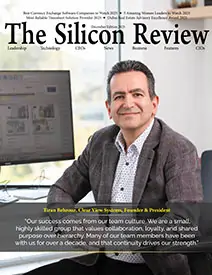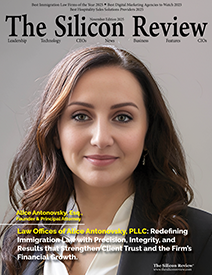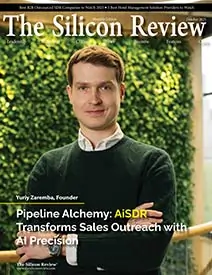50 Best Companies to Watch 2024
RiMM: A Santoku Corporation Innovation Revolutionizing Disaster Safety Education with Virtual Reality
The Silicon Review
![]()
“Many users who have used the product for more than three years have reported that the VR danger experience education has increased people’s sensitivity to danger and reduced the number of disasters that have occurred.”
Susumu Matsuda, Executive Director at Santoku Corporation, pursued studies in automatic control theory during his time at a university, which laid a strong foundation for his career. He then explored learning microcontroller architecture at an electrical manufacturer, where he honed his skills in microcontroller hardware design, firmware design, and machine control over a period of 13 years.
Following the tragic events of the 9/11 terrorist attacks in 2001, Matsuda shifted gears and ventured into the field of virtual reality. This led to the establishment of a VR programming company in Tokyo in 2005, followed by a 3D model production company in Ho Chi Minh City in 2009, demonstrating his entrepreneurial spirit and global vision.
In 2012, Matsuda conceptualized Risk Management Method, or RiMM, at Santoku Corporation, and began developing its core software and systems. By 2014, he successfully brought RiMM to market, marking the pioneering launch of a VR product dedicated to safety education.
By 2019, Matsuda consolidated his efforts by integrating various organizations under his leadership. By 2020, he articulated a profound goal of “touching people’s hearts directly”, driving his focused research agenda towards safety and security, particularly in the biological and life sciences fields.
In 2022, Matsuda introduced the “Cyclone Philosophy”, representing his visionary ideals. His career trajectory showcases not only his technical prowess but also his innovative spirit and dedication to making a positive impact on society.
Santoku Corporation, a global company initially established for import, manufacturing and sales of fasteners and specialized manufacturing, has dedicated its efforts to pioneering advancements in Virtual Reality technology.
The Silicon Review had the privilege of interviewing Mr. Matsuda to explore RiMM’s profound impact on society.
![]()
Interview Highlights
Q. What was Santoku Corporation’s vision behind developing RiMM, and how has this vision influenced the direction and impact of the company’s VR safety solutions?
Since the start of the business in 2001, we have been exploring ways to develop products with added value by combining VR visualization with image processing and microcomputer control. Our safety initiatives began when a research institute requested that we use VR to recreate disaster events as a way to increase human safety. As a result, we began developing a method to visually increase memory effects, as there was a demand for VR to experience disasters with a high memory effect. Many research institutes have proven that VR created using this method can communicate disasters to people using only their eyes.
Q. How has the shift from custom-made VR products to packaged VR solutions using RiMM allowed Santoku to better meet market needs and enhance safety measures?
It turns out that VR product development takes time, and the costs of playback hardware and VR content development are obstacles to implementation. To address this, in 2012, we began working to reduce obstacles. We modularized the developed software and 3D data in a form that can be reused. We developed a tool that uses a library of 3D data to layout 3D environments with drag and drop. We developed basic software that uses a library of modularized functions to edit programs in chart format. By using both functions, it becomes possible to develop VR software in less than 50% of the development time and cost compared to conventional methods. In addition, a secondary effect is achieved where users who are unable to write programs in a written format can develop VR programs in a flow format. This makes it easier to trial and error the development of experiential content that improves safety awareness.
![]()
Q. In what ways does the RiMM VR disaster experience differ from normal VR in terms of sensory engagement and emotional impact on the user?
From 2014, through the commercialization work of experiencing disasters, we learned that vision alone cannot entirely affect people’s emotions. In the process of recreating various disasters, we learned that only the five senses felt in the body can impact negative emotions. This led to the development of units that reproduce bodily sensations. Development and commercialization work progressed for hardware units derived from robot control technology, such as a motion base that reproduces the sense of balance, skin sensations using air blowing, tactile reproduction using vibrators, and pain sensation reproduction using high-frequency discharge.
Currently, we have achieved the reproduction of up to eight senses (sight, hearing, balance sense, skin sensation, touch, pain, force, and smell) including the sense of smell. We will establish a method to efficiently experience negative danger by experiencing it with five senses according to the type of disaster. The experience of a disaster is transmitted to the brain through all the nerves of the body through the five senses. Only by experiencing the appropriate sensations with the appropriate stimuli according to the disaster can people’s emotions be stirred, and the sensations are remembered by the body.
Q. Could you share a testimonial highlighting how RiMM has positively impacted society’s safety protocols or disaster preparedness strategies?
By repeating the cycle of feedback from the people who experienced the disaster and improving the software, we have experimentally found ways to improve the memory effect. It is known that people tend to think of disasters as something that does not concern them, and more than 130 disaster experience scenarios corresponding to 34 fields have been commercialized to prevent people from thinking of disasters as something that does not concern them.
In addition, many users who have used the product for more than three years have reported that the VR danger experience education has increased people’s sensitivity to danger and reduced the number of disasters that have occurred. At the beginning of development in 2014, there was resistance to disclosing disaster information to the outside world, and it was difficult to obtain
disaster information. We have continued to appeal to society for more than several years that a system for sharing disaster information is safe and effective, and now we are actively obtaining disaster information from users. By creating a database of disaster information in a way that does not identify the person and place that caused the disaster, and sharing it with society, we can increase safety beyond language and cultural barriers.
Q. As the manufacturer of RiMM, is there anything else you would like to highlight before we wrap up?
In order to make effective use of the disaster database, we will conduct case studies of many disasters that can occur at the site. A typical disaster case study is experienced through VR to increase people’s danger sensitivity. Next, safety education (safe work procedures, promotion of the use of protective equipment, and how to avoid danger) is provided to protect the body. By repeating these three steps, safety can be increased. Research and development are underway on a mechanism to optimize negative physical stimuli during the physical experience in order to reduce the impact on the mind of experiencing a disaster through the five senses. It is already possible for operators to adjust and experience negative physical stimuli in three to five stages. A mechanism is under development to automatically detect emotions during the physical experience, evaluate emotions, and automatically optimize negative physical stimuli. To further improve safety and prove the effectiveness of our products, we are conducting research and development that utilizes biological science to derive effects from theoretical human characteristics.
In addition to confirming the effect of improving danger sensitivity, verification is also underway to verify that moderate emotional experience improves people’s memory effects. Research is progressing in brain science, psychology, and neurology, and it is beginning to be found that moderate fearful physical experience activates neurogenesis related to the brain’s memory effects. It is also beginning to be found that moderate joyful physical experience generates neurogenesis. Learning how the brain works in this way makes it easier to create an effective safety education curriculum. In addition, experiencing fear and joy appropriately is effective in improving memory. In this way, research and development that learns human characteristics from biological science to improve safety is important for theoretically verifying the effectiveness of disaster experience using VR.
It’s being operated in eight countries, mainly in the Asia Pacific, and is available in multiple languages. Since October 2023, it has been regularly participating in exhibitions in North America.
_2025-12-15_12-44-58.webp)


_2025-11-17_06-38-14.webp)

 (1)_2025-10-21_13-35-14.webp)
